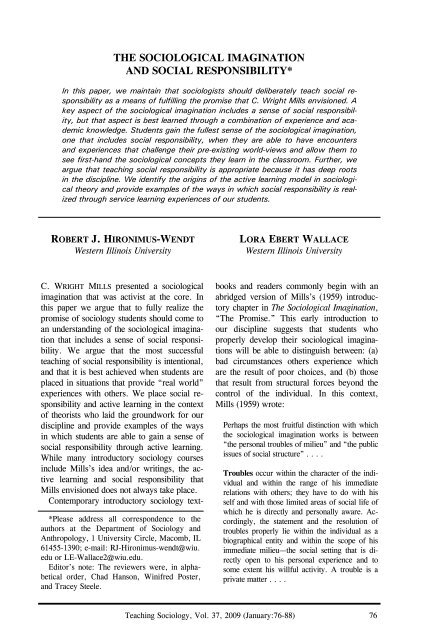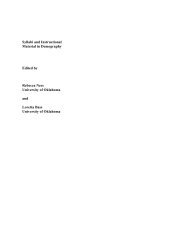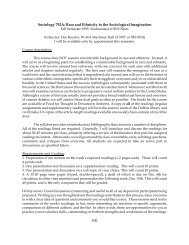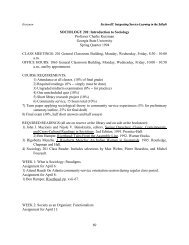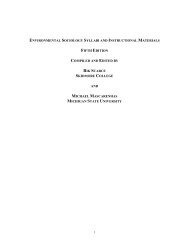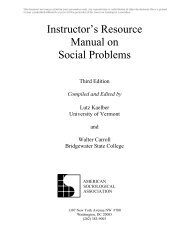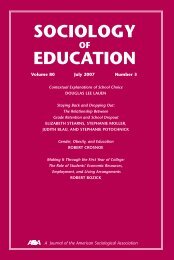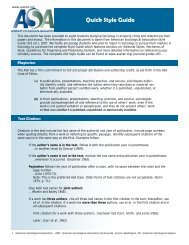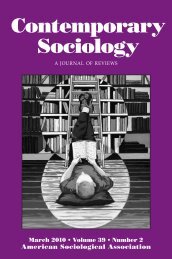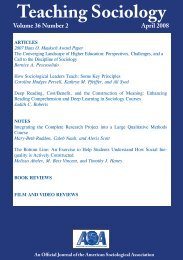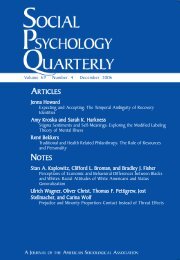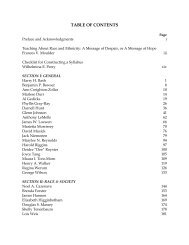Teaching Sociology - American Sociological Association
Teaching Sociology - American Sociological Association
Teaching Sociology - American Sociological Association
Create successful ePaper yourself
Turn your PDF publications into a flip-book with our unique Google optimized e-Paper software.
THE SOCIOLOGICAL IMAGINATION<br />
AND SOCIAL RESPONSIBILITY*<br />
In this paper, we maintain that sociologists should deliberately teach social responsibility<br />
as a means of fulfilling the promise that C. Wright Mills envisioned. A<br />
key aspect of the sociological imagination includes a sense of social responsibility,<br />
but that aspect is best learned through a combination of experience and academic<br />
knowledge. Students gain the fullest sense of the sociological imagination,<br />
one that includes social responsibility, when they are able to have encounters<br />
and experiences that challenge their pre-existing world-views and allow them to<br />
see first-hand the sociological concepts they learn in the classroom. Further, we<br />
argue that teaching social responsibility is appropriate because it has deep roots<br />
in the discipline. We identify the origins of the active learning model in sociological<br />
theory and provide examples of the ways in which social responsibility is realized<br />
through service learning experiences of our students.<br />
ROBERT J. HIRONIMUS-WENDT<br />
Western Illinois University<br />
C. WRIGHT MILLS presented a sociological<br />
imagination that was activist at the core. In<br />
this paper we argue that to fully realize the<br />
promise of sociology students should come to<br />
an understanding of the sociological imagination<br />
that includes a sense of social responsibility.<br />
We argue that the most successful<br />
teaching of social responsibility is intentional,<br />
and that it is best achieved when students are<br />
placed in situations that provide “real world”<br />
experiences with others. We place social responsibility<br />
and active learning in the context<br />
of theorists who laid the groundwork for our<br />
discipline and provide examples of the ways<br />
in which students are able to gain a sense of<br />
social responsibility through active learning.<br />
While many introductory sociology courses<br />
include Mills’s idea and/or writings, the active<br />
learning and social responsibility that<br />
Mills envisioned does not always take place.<br />
Contemporary introductory sociology text-<br />
*Please address all correspondence to the<br />
authors at the Department of <strong>Sociology</strong> and<br />
Anthropology, 1 University Circle, Macomb, IL<br />
61455-1390; e-mail: RJ-Hironimus-wendt@wiu.<br />
edu or LE-Wallace2@wiu.edu.<br />
Editor’s note: The reviewers were, in alphabetical<br />
order, Chad Hanson, Winifred Poster,<br />
and Tracey Steele.<br />
LORA EBERT WALLACE<br />
Western Illinois University<br />
books and readers commonly begin with an<br />
abridged version of Mills’s (1959) introductory<br />
chapter in The <strong>Sociological</strong> Imagination,<br />
“The Promise.” This early introduction to<br />
our discipline suggests that students who<br />
properly develop their sociological imaginations<br />
will be able to distinguish between: (a)<br />
bad circumstances others experience which<br />
are the result of poor choices, and (b) those<br />
that result from structural forces beyond the<br />
control of the individual. In this context,<br />
Mills (1959) wrote:<br />
Perhaps the most fruitful distinction with which<br />
the sociological imagination works is between<br />
“the personal troubles of milieu” and “the public<br />
issues of social structure” . . . .<br />
Troubles occur within the character of the individual<br />
and within the range of his immediate<br />
relations with others; they have to do with his<br />
self and with those limited areas of social life of<br />
which he is directly and personally aware. Accordingly,<br />
the statement and the resolution of<br />
troubles properly lie within the individual as a<br />
biographical entity and within the scope of his<br />
immediate milieu—the social setting that is directly<br />
open to his personal experience and to<br />
some extent his willful activity. A trouble is a<br />
private matter . . . .<br />
<strong>Teaching</strong> <strong>Sociology</strong>, Vol. 37, 2009 (January:76-88) 76


